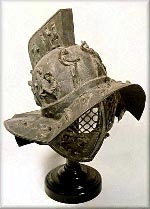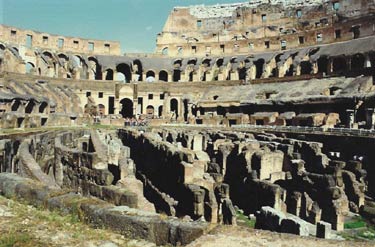Whitesnake
on tour
Polanski
on the run,
but still wins Oscar
Kristen
French memorial
Shuttle
and Purple?
Hemingway
sex change
Nero
nasty
Nero's
Golden House

I will be honest with you. I have no idea what this
picture is about, but it has Russell Crowe in front of the coliseum
- 'nuf for me.
Gladiators

Gladiatorial
combat originated as part of funerary rites as a form of human sacrifice.
By the 1st Century BC, gladiatorial games had far outstripped this ritual
context; Caesar exhibited 320 pairs of gladiators in 65 BC, Augustus
and Trajan each showed 5000 pairs of gladiators on different occasions.
Gladiators
were prisoners of war, slaves sold to gladiatorial schools, or volunteers.
They were differently equipped, some with heavy swords and shields and
others almost naked, armed with a net and a trident. Pairings were made
to match a heavily armed gladiator against a lightly armed one. Bouts
were not necessarily to the death.
A
defeated gladiator could appeal to the crowd and the presiding magistrate
who could signal that he had fought well and deserved to be spared.
Thumbs down, however, meant death, which the defeated man was expected
to face with quiet courage. Although gambling was technically illegal
in Rome, vast sums were wagered on gladiatorial combats. Successful
gladiators were popular heroes and lived to enjoy a comfortable retirement,
with some running their own training schools.
|
 Coliseum
still stands as an architectural wonder
Coliseum
still stands as an architectural wonder
Thousands lost their lives
within these circular walls. The blood spilled here could probably keep
the Canadian Red Cross going for hundreds of years - bloody killings,
maimings, decapitations, dismemberment, burnings at the stake - thousands
of Christians were reportedly killed here - some deny that fact. One story
has it that to take suspicion away from himself, Nero blamed the Christians
for the great fire.
One of the most ironic twists
in the story of Rome and the coliseum is the fact that if Christians were
killed here because of their views, several hundred years later one of
the rulers of the Roman Empire was a Christian, Constantine. The society
that once persecuted Christians on the level of the Holocaust eventually
embraced the religion.
The coliseum still stands,
albeit in very poor shape. One of the things that is eroding the centuries-old
landmark the most is pollution - pollution from the thousands of mopeds
that cruise by the site by the second. The Roman government, last I heard,
is hoping to place on ban on the use of mopeds in order to stave off further
erosion.
I don't know what it is about
this part of history, but the story of Rome, and of the coliseum, enthralls
me. Gladiator, Quo Vadis? Spartacus - I don't miss a word of dialogue
or a second of cinematography.
Yet those images are far different from what stands there now. Whole sections
of the coliseum are gone, from earthquakes and looting. The marble sheen
that once adorned its walls long gone. Every opening of the building was
once decorated with a statue - all gone. The walls are pitted and crumbling.
The wooden floor that once echoed with the footfalls of bloodthirsty gladiators
is gone. In reality, many of those gladiators were probably much like
you and me and praying to their god that they survived their time inside.
Now you can see what was
below that wooden floor - what is left of it anyway. The remnants of the
lower area are in poor shape. The lower area was used for many things:
to house the wild animals that would eventually find their way topside;
to hold the Christians and slaves and foreigners who would eventually
find their way into the bloody arena. There were also an assortment of
mechanical devices used to raise and lower cells doors and ramps that
would lead the animals to the top. From the picture below, the coliseum
looks small, but the picture is deceiving. I believe there is a group
of people standing in the far doorway, but they are dwarfed by the building.

Image Copyrighted
by Historylink101.com and found at Italy and Rome Picture Gallery
The coliseum got its name from the huge statue of Emperor
Nero some 30 meters high which once stood near the entrance to his Golden
House. The coliseum was originally known as the Flavian Amphitheater and
stands in an area once occupied by the lake of Nero's Domus Aureus, the
Golden House. The coliseum was begun during Emperor Vespasian's reign
in 72 A.D. and completed by his son Titus in 80 A.D. It was inaugurated
with 100 days of games and festivals in which it is said that 9,000 wild
animals and some 2,000 gladiators lost their lives. Many gladiatorial
contests were staged as re-enactments of major Roman conquests and victories
over their enemies. The structure could seat up to 55,000 spectators.
The arena or floor of the amphitheater was 258 feet long
and 150 feet wide. Around the arena's edge stood the "podium"
wall about 15 feet high - which at times, was topped by a trellis or net
to protect the spectators. The wood floor of the central exhibition area
was covered with "harena", latin for sand, which gives us the
term "arena" still used today for a large structure intended
for the display of sports, circuses or other spectacles. It is also said
the main purpose of the sand on the floor was to soak up all the blood.
Earlier in its history, the coliseum was also used for mock
naval battles. The floor would be taken away and the lower area was flooded.
Mock naval battles then took place, usually recreations of victorious
Roman battles. The practice was eventually stopped and the floor made
permanent.
One topic of contention still remains is what exactly was
used as a cover for the coliseum - and how exactly it operated. There
is no evidence left to answer those questions. There are remains of post
holders on the exterior of the building. What is known is that very long
posts were inserted into the holdings and ran up the side of the building
to the top. But what experts can't agree on is exactly what kind of system
was used to cover the spectators from the sun's glare. Either way, it
is likely that canvas was used. While surfing the 'net for information
on this, I even found a mention that the roof was made of wood! I don't
think so.
What is known is that sailors were used to operate the awning,
drawing it out when ordered, and bringing it back in. What is not known
is how far the awning extended into the coliseum. One theory tells of
many ropes extending far into the arena where they meet a circular section
of rope. The canvas is then played out along these ropes. But that theory
is contested because all that rope extending for so far would be very
heavy and would probably collapse under its own weight.
There are depictions on coins, but such recreations cannot
be considered proof. Another theory involves the use of masts and pulleys.
The masts would hold horizontal masts on which to pull the awning over.
Here it is believed that it did not cover the whole structure, but at
least the most important seatings of the emperor for the whole day.
I saw a show on an educational station recently involving
just this topic. There were two teams, and each was working on their theory
of the roof. They performed their experiment in an existing amphitheatre,
much smaller than the one in Rome. One team tried to recreate the rope
theory, and the other, the mast and pulley theory. It wasn't easy work,
and they were only recreating a small portion of a roof - one can imagine
the work it took to do this in the coliseum.
Results proved inconclusive, as both teams had a lot of
trouble making their recreations actually work.
|

Statistics
*constructed
during the reign of Emperor Vespasian, and completed in 80 AD. (12 years
after Nero's death)
*took
10 years to build and, at the time of its completion, it was the largest
structure of its kind in the ancient world
*the
coliseum is a four story structure, and is about 160 feet high with
80 entrances
*during
the time it was in use, the stadium was capable of holding more than
50,000 spectators
*although
the coliseum had no roof, in the summer an enormous canvas sheet was
often attached over the top of the structure to protect the spectators
from the hot sun
*the
coliseum was in regular use for about 400 years. After the Roman Empire
fell, the stadium was abandoned for hundreds of years until Medieval
times, when it was used as a fortress
*the
structure is slowly being restored. Even in its present state of ruin,
the structure is breathtaking to view
*today,
visitors may enter the coliseum and tour the interior of this fascinating
ancient structure. The coliseum is open every day, except during national
holidays
*after
two-thirds of Rome were ruined by the great fire in 64 A.D., Nero used
this land as a site for his new palace, Domus
Aurea or "Golden House", including rooms and hallways
lavishly decorated in gold. One of the most visible features of the
Domus Aurea was the Colossus Neronis: a 37-meter-high bronze statue
of Nero placed just outside of the entrance. This monstrosity was built
in imitation of the Colossus of Rhodes, one of the Seven
Wonders of the Ancient World. Later, the colossus was affixed with
the heads of several emperors before Hadrian moved it to the coliseum.
This building took the name coliseum in the Middle Ages, so called after
the statue outside of it. The name stuck and is used to this day.
|






